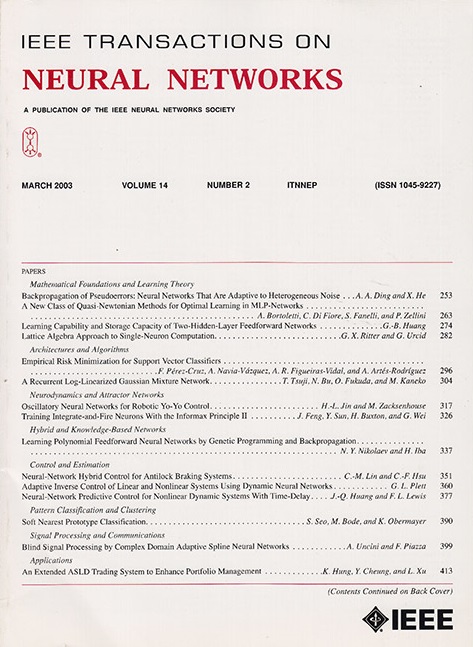Physics-Guided Time-Interactive-Frequency Network for Cross-Domain Few-Shot Hyperspectral Image Classification.
IF 8.9
1区 计算机科学
Q1 COMPUTER SCIENCE, ARTIFICIAL INTELLIGENCE
IEEE transactions on neural networks and learning systems
Pub Date : 2025-09-23
DOI:10.1109/tnnls.2025.3608294
引用次数: 0
Abstract
Recently, domain alignment and metric-based few-shot learning (FSL) have been introduced into hyperspectral image classification (HSIC) to solve the issues of uneven data distribution and scarcity of annotated data faced in practical applications. However, existing cross-domain few-shot methods ignore pivotal frequency priors of the complex field, which contribute to better category discrimination and knowledge transfer. To address this issue, we propose a novel physics-guided time-interactive-frequency network (PTFNet) for cross-domain few-shot HSIC, enabling the extraction of both frequency priors and spatial features (termed "time domain" following Fourier convention) simultaneously through a lightweight time-interactive-frequency module (TiF-Module) as a pioneering effort. Meanwhile, a spectral Fourier-based augmentation module (SFA-Module) is designed to decouple the frequency priors and enhance the diversity of distribution of physical attributes to imitate the domain shift. Then, the physics consistency loss is introduced to regularize the diverse embeddings to approximate the center of each category's physical attributes, guiding the network to excavate more transferable knowledge of source domain (SD). Furthermore, to fully exploit the discriminant time-frequency information and further improve the accuracy of boundary pixels, a set of multiorientation homogeneous prototypes is adopted to represent each class comprehensively, and an intuitive and flexible uncertainty-rectified bidirectional random walk strategy is applied to replace the Euclidean metric for more reliable classification. The experimental results on four public datasets demonstrate the prominent performance of the proposed PTFNet.跨域少镜头高光谱图像分类的物理制导时频交互网络。
近年来,将领域对准和基于度量的少镜头学习(FSL)引入到高光谱图像分类中,以解决实际应用中数据分布不均匀和标注数据稀缺的问题。然而,现有的跨域少射方法忽略了复杂领域的关键频率先验,有助于更好的分类识别和知识转移。为了解决这个问题,我们提出了一种新的物理引导的时间-交互-频率网络(PTFNet),用于跨域少射HSIC,通过轻量级的时间-交互-频率模块(TiF-Module)同时提取频率先验和空间特征(按照傅里叶约定称为“时域”),作为开创性的努力。同时,设计了一个基于频谱傅里叶的增强模块(SFA-Module)来解耦频率先验和增强物理属性分布的多样性,以模拟域移。然后,引入物理一致性损失对不同的嵌入进行正则化,以逼近每个类别的物理属性中心,引导网络挖掘出更具可转移性的源域知识(SD)。此外,为了充分利用鉴别时频信息,进一步提高边界像素的精度,采用一组多向同构原型对每一类进行综合表示,并采用直观灵活的不确定性校正双向随机游走策略取代欧几里得度量,实现更可靠的分类。在4个公共数据集上的实验结果表明,所提出的PTFNet具有良好的性能。
本文章由计算机程序翻译,如有差异,请以英文原文为准。
求助全文
约1分钟内获得全文
求助全文
来源期刊

IEEE transactions on neural networks and learning systems
COMPUTER SCIENCE, ARTIFICIAL INTELLIGENCE-COMPUTER SCIENCE, HARDWARE & ARCHITECTURE
CiteScore
23.80
自引率
9.60%
发文量
2102
审稿时长
3-8 weeks
期刊介绍:
The focus of IEEE Transactions on Neural Networks and Learning Systems is to present scholarly articles discussing the theory, design, and applications of neural networks as well as other learning systems. The journal primarily highlights technical and scientific research in this domain.
 求助内容:
求助内容: 应助结果提醒方式:
应助结果提醒方式:


